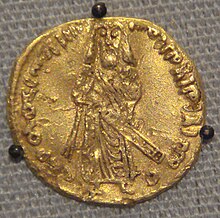
Back عبد الملك بن مروان Arabic عبد الملك بن مروان ARZ عبدالملک بن مروان AZB Абдул-Малік ібн Мерван Byelorussian Абд ал-Малик ибн Маруан Bulgarian আবদুল মালিক ইবনে মারওয়ান Bengali/Bangla Abd al-Malik Breton Abd-al-Màlik ibn Marwan Catalan عەبدولمەلیک کوڕی مەروان CKB Abdulmalik Czech
| Abd al-Malikعَبْد الْمَلِك | |||||
|---|---|---|---|---|---|
 | |||||
| 5th Caliph of the Umayyad Caliphate | |||||
| Reign | 12 April 685 – 9 October 705 | ||||
| Predecessor | Marwan I | ||||
| Successor | Al-Walid I | ||||
| Born | July/August 644 or June/July 647 Medina, Rashidun Caliphate | ||||
| Died | 9 October 705 (aged 58–61) Damascus, Umayyad Caliphate | ||||
| Burial | Outside of Bab al-Jabiya, Damascus | ||||
| Spouse |
| ||||
| Issue | |||||
| |||||
| House | Marwanid | ||||
| Dynasty | Umayyad | ||||
| Father | Marwan I | ||||
| Mother | A'isha bint Mu'awiya | ||||
| Religion | Islam | ||||
Abd al-Malik ibn Marwan ibn al-Hakam (Arabic: عَبْد الْمَلِك ٱبْن مَرْوَان ٱبْن الْحَكَم, romanized: ʿAbd al-Malik ibn Marwān ibn al-Ḥakam; July/August 644 or June/July 647 – 9 October 705) was the fifth Umayyad caliph, ruling from April 685 until his death in October 705. A member of the first generation of born Muslims, his early life in Medina was occupied with pious pursuits. He held administrative and military posts under Caliph Mu'awiya I (r. 661–680), founder of the Umayyad Caliphate, and his own father, Caliph Marwan I (r. 684–685). By the time of Abd al-Malik's accession, Umayyad authority had collapsed across the Caliphate as a result of the Second Fitna and had been reconstituted in Syria and Egypt during his father's reign.
Following a failed invasion of Iraq in 686, Abd al-Malik focused on securing Syria before making further attempts to conquer the greater part of the Caliphate from his principal rival, the Mecca-based caliph Abd Allah ibn al-Zubayr. To that end, he concluded an unfavorable truce with the reinvigorated Byzantine Empire in 689, quashed a coup attempt in Damascus by his kinsman, al-Ashdaq, the following year, and reincorporated into the army the rebellious Qaysi tribes of the Jazira (Upper Mesopotamia) in 691. He then conquered Zubayrid Iraq and dispatched his general, al-Hajjaj ibn Yusuf, to Mecca where he killed Ibn al-Zubayr in late 692, thereby reuniting the Caliphate under Abd al-Malik's rule. The war with Byzantium resumed, resulting in Umayyad advances into Anatolia and Armenia, the destruction of Carthage and the recapture of Kairouan, the launchpad for the later conquests of western North Africa and the Iberian Peninsula, in 698. In the east, Abd al-Malik's viceroy, al-Hajjaj, firmly established the caliph's authority in Iraq and Khurasan, stamping out opposition by the Kharijites and the Arab tribal nobility by 702. Abd al-Malik's final years were marked by a domestically peaceful and prosperous consolidation of power.
In a significant departure from his predecessors, rule over the Caliphate's provinces was centralized under Abd al-Malik, following the elimination of his rivals. Gradually, loyalist Arab troops from Syria were tasked with maintaining order in the provinces as dependence on less reliable, local Arab garrisons was reduced. Tax surpluses from the provinces were forwarded to Damascus and the traditional stipends to veterans of the early Muslim conquests and their descendants were abolished, salaries being restricted to those in active service. The most consequential of Abd al-Malik's reforms were the introduction of a single Islamic currency in place of Byzantine and Sasanian coinage and the establishment of Arabic as the language of the bureaucracy in place of Greek and Persian in Syria and Iraq, respectively. His Muslim upbringing, the conflicts with external and local Christian forces and rival claimants to Islamic leadership all influenced Abd al-Malik's efforts to prescribe a distinctly Islamic character to the Umayyad state. Another manifestation of this initiative was his founding of the Dome of the Rock in Jerusalem, the earliest archaeologically attested religious monument built by a Muslim ruler and the possessor of the earliest epigraphic proclamations of Islam and the Islamic prophet Muhammad. The foundations established by Abd al-Malik enabled his son and successor, al-Walid I (r. 705–715), who largely maintained his father's policies, to oversee the Umayyad Caliphate's territorial and economic zenith. Abd al-Malik's centralized government became the prototype of later medieval Muslim states.
- ^ Hoyland 2007, p. 594.
- ^ Hoyland 2007, pp. 593–596.
Cite error: There are <ref group=lower-alpha> tags or {{efn}} templates on this page, but the references will not show without a {{reflist|group=lower-alpha}} template or {{notelist}} template (see the help page).
© MMXXIII Rich X Search. We shall prevail. All rights reserved. Rich X Search